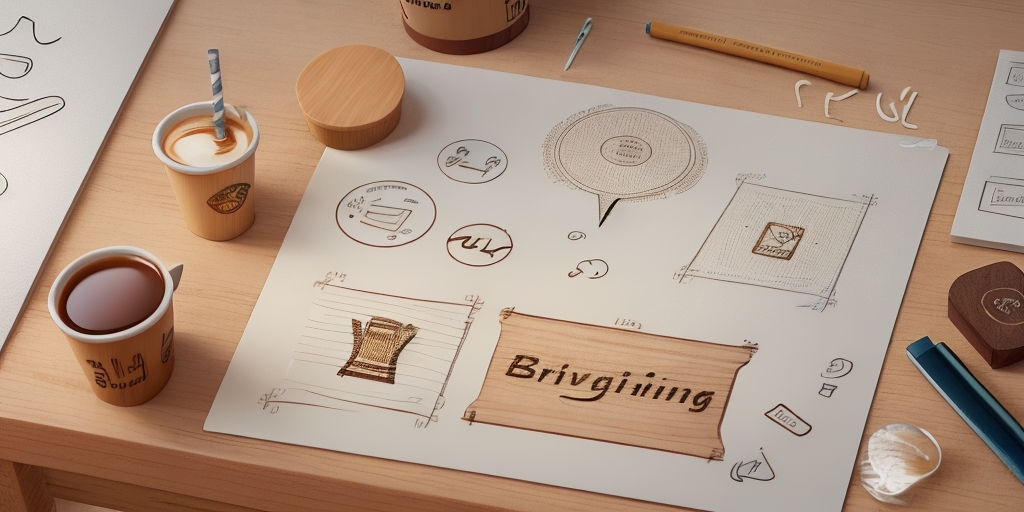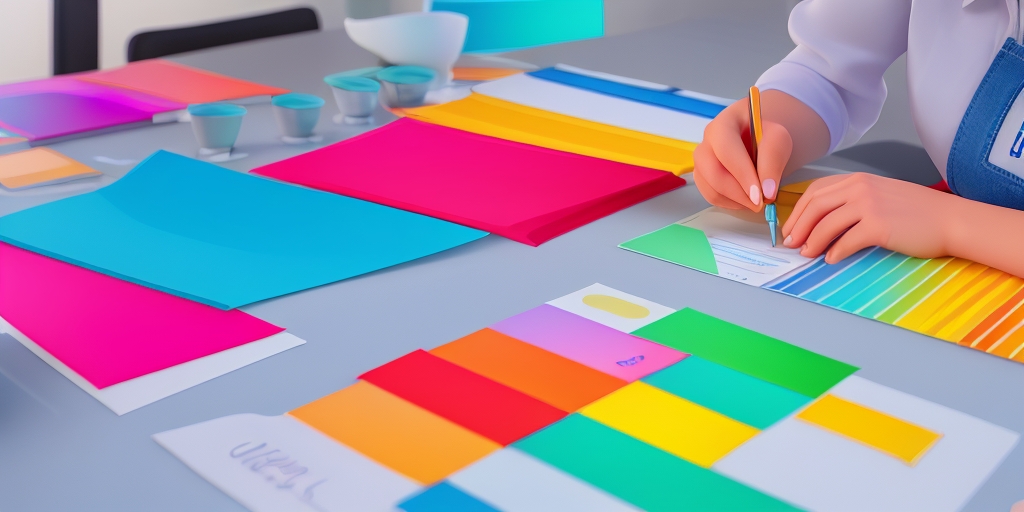Crafting Impactful Logos: Your Design Manual
I am a creative and analytical person who enjoys problem-solving and finding creative solutions. I am driven by curiosity and a passion for learning, and take initiative to explore and understand new concepts. I am a great communicator and collaborate well with others, and am always looking for opportunities to improve myself and my team.
Crafting Impactful Logos: Your Design Manual
Understanding the Challenges in Logo Design

Designing a logo is not as easy as it seems. It's a process that involves creativity, technical skills, and a deep understanding of your brand and audience. Many people struggle with this process for various reasons:
- Lack of design skills: Not everyone is a skilled designer. If you're not familiar with design principles and software, creating a logo can be a daunting task.
- Not knowing where to start: Even if you have some design skills, you might feel overwhelmed by the blank canvas. What colors should you use? What font? What should the logo look like?
- Struggling to convey the brand's identity: Your logo should reflect your brand's personality and values. But how do you translate these abstract concepts into a visual design?
Offering a Solution
Don't worry, we've got you covered. In this guide, we'll walk you through the process of designing a logo, step by step. We'll discuss everything from understanding your brand and audience to choosing the right design tools and finalizing your logo. We'll also provide you with resources and tips to make the process easier and more effective. Ready to create a logo that stands out? Let's dive in!
But before we get started, it's important to understand your brand and audience. Why is this so crucial in logo design? Stay tuned to find out in the next section.
Getting Started with Logo Design

Before you dive into the world of logo design, it's crucial to understand two key elements: your brand and your audience. These two factors will guide your design process and help you create a logo that truly represents your business and appeals to your target market.
Understanding Your Brand
First things first, you need to define your brand identity and values. This is the foundation of your logo design. Your logo should be a visual representation of what your brand stands for. Here are a few steps to help you define your brand:
- Define your mission: What is the purpose of your business? What are your goals?
- Identify your values: What principles guide your business operations?
- Understand your unique selling proposition: What makes your business stand out from the competition?
Once you have a clear understanding of your brand, you can start to visualize it. Think about colors, shapes, and symbols that align with your brand identity. For example, if your brand values sustainability, you might consider using green in your logo to represent nature and growth.
Understanding Your Audience
Next, you need to identify and understand your target audience. Your logo should be designed with your audience in mind. After all, these are the people you want to connect with and attract to your business. Here's how you can get to know your audience:
- Identify your target market: Who are your ideal customers? Consider factors like age, location, and interests.
- Understand their preferences: What styles and designs appeal to them? What colors do they associate with positive emotions?
- Know their needs: What problems does your business solve for them?
For instance, if your target audience is young and trendy, you might opt for a modern and minimalist logo design. On the other hand, if your audience is more traditional, a classic and elegant design might be more appropriate.
As Paul Rand, a renowned graphic designer, once said, "Design is the silent ambassador of your brand." Your logo speaks volumes about your brand, even when you're not there to do the talking. So, it's essential to get it right.
Now that you have a solid understanding of your brand and audience, you're ready to move on to the next step: choosing the right tools for logo design. But with so many options out there, how do you pick the right one? Stay tuned to find out!
Choosing the Right Tools for Logo Design
Now that you have a clear understanding of your brand and audience, it's time to dive into the exciting world of logo design tools. The right tool can make the difference between a logo that's just okay and one that's truly spectacular. But with so many options out there, how do you choose?
Free Logo Design Tools
Let's start with the freebies. If you're just starting out or working with a tight budget, free logo design tools can be a lifesaver. Adobe Spark is a great example. It's user-friendly, offers a variety of templates, and best of all, it's free! You can experiment with different designs until you find one that resonates with your brand.
Other free tools worth checking out include FreeLogoDesign and Hatchful Logo Maker. These platforms offer a range of design options and are perfect for beginners. They provide a simple, step-by-step process to help you create a logo that truly represents your brand.
Remember, the best tool is the one that fits your needs and skill level. As the famous designer Paul Rand once said, "Design is so simple, that's why it is so complicated." So, take your time to explore different tools and find the one that works best for you.
Now that you're equipped with the right tools, are you ready to start designing your logo? What if we told you that the secret to a great logo lies in the initial idea and the mood board? Stay tuned to learn how to generate logo ideas and create a mood board that will guide your design process.
Designing Your Logo

Now that you've chosen your tools and have a clear understanding of your brand, it's time to dive into the exciting part - designing your logo. This process is where your creativity truly shines, and your brand begins to take shape visually. Remember, your logo is the face of your brand, so it's crucial to get it right.
Generating Logo Ideas
Before you start sketching, it's essential to brainstorm and generate as many logo ideas as possible. This process can be as simple as jotting down words associated with your brand, sketching rough ideas, or creating a mood board. A mood board is a collection of images, colors, fonts, and other visual elements that inspire you and represent your brand's vibe.
For instance, if you're creating a logo for a coffee shop, your mood board might include images of coffee beans, cups, cozy interiors, and warm color palettes. This process helps you visualize your brand and provides a reference point for your logo design.
Choosing Logo Colors and Typography
Once you have a clear idea of your logo's direction, it's time to choose your colors and typography. These elements play a significant role in conveying your brand's personality. According to a study by the Pantone Color Institute, color increases brand recognition by up to 80%.
- Colors: Each color has a different psychological impact. For example, blue often represents trust and reliability, while red can signify passion and energy. Choose colors that align with your brand's identity. If you're unsure, refer back to your mood board for inspiration.
- Typography: The font you choose should be legible and reflect your brand's character. For instance, a tech company might opt for a sleek, modern font, while a bakery might choose a more whimsical, hand-drawn style.
As Paul Rand, a renowned graphic designer, once said, "Design is the silent ambassador of your brand." Your logo's colors and typography are key ambassadors, silently communicating your brand's personality to your audience.
Now that you've designed your logo, you might be wondering, "What's next?" Well, the journey doesn't end here. The next step is to test your logo and ensure it works in different contexts. But how do you do that? Stay tuned to find out.
Finalizing and Launching Your Logo
.jpg)
Now that you've designed your logo, it's time to take the final steps to bring it to life. This involves testing your logo in various contexts and launching it in a way that aligns with your brand's identity. Let's dive into these steps.
Testing Your Logo
Before you officially launch your logo, it's crucial to test it. This ensures that your logo works well in different contexts and mediums. For instance, how does it look on your website? What about on a business card or a billboard? Does it maintain its integrity when scaled up or down?
One way to test your logo is to use it in mockups. There are various online tools that allow you to place your logo on different items, such as t-shirts, mugs, and stationery. This gives you a realistic view of how your logo will look in real-world applications.
Another aspect to consider is how your logo looks in black and white. There may be situations where your logo needs to be displayed without color, so it's important to ensure it still communicates your brand effectively in grayscale.
Launching Your Logo
Once you're satisfied with your logo, it's time to launch it. But how do you do this effectively?
Firstly, consider doing an internal launch. This means introducing your new logo to your team first. This not only builds excitement within your company but also allows for any last-minute tweaks based on feedback.
Next, ensure all your brand materials are aligned with your new logo. This includes your website, social media profiles, business cards, and any other places where your logo is displayed. Consistency is key in branding, so it's important that your new logo is reflected across all platforms.
Finally, announce your new logo to your audience. This could be through a social media post, an email newsletter, or a blog post on your website. Make sure to communicate why you've designed a new logo and what it represents for your brand.
Now that you've launched your logo, what's next? How do you ensure your logo stays relevant and effective over time? Stay tuned as we delve into maintaining your logo in the next section.
Maintaining Your Logo Over Time
Designing a logo is not a one-time event. It's a process that evolves with your brand. As your business grows and changes, so should your logo. It's crucial to keep your logo updated and relevant to maintain a strong brand identity.
When to Update Your Logo
Knowing when to update your logo can be tricky. It's not about changing it every year, but rather recognizing the signs that it might be time for a refresh. Here are a few indicators:
- Outdated design: If your logo looks like it belongs in the 90s, it's probably time for an update. Design trends change, and while your logo should be timeless, it shouldn't look outdated.
- Business evolution: If your business has significantly evolved or expanded its services, your logo should reflect these changes.
- Complexity: If your logo is too complex or detailed, it might not be easily recognizable or versatile. Simplifying your logo can make it more effective.
For instance, Starbucks updated their logo in 2011, removing the brand name and focusing on the iconic mermaid image. This change reflected the company's expansion beyond coffee into a broader range of products and services.
How to Update Your Logo
Updating your logo doesn't mean starting from scratch. The goal is to maintain brand recognition while improving the design. Here's how to go about it:
- Keep key elements: Identify the elements in your logo that are most recognizable and keep them in the new design.
- Simplify: Remove unnecessary details to make your logo more versatile and easy to recognize at a glance.
- Modernize: Update fonts and colors to give your logo a fresh, contemporary look.
Take the example of Apple. Their logo has evolved from a detailed illustration of an apple to a simple, sleek silhouette, maintaining the same basic shape while modernizing the design.
Wrapping Up
In conclusion, designing a logo is a journey, not a destination. It's about understanding your brand, choosing the right tools, creating a design that reflects your identity, launching it effectively, and keeping it updated over time. So, don't be afraid to evolve and adapt your logo as your business grows. Now, it's time to start designing your logo. Remember, a well-designed logo is a powerful tool for your brand. Make it count!



.jpg)
.jpg)

.jpg)
.jpg_nowm_1260.jpg)